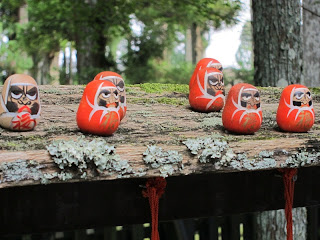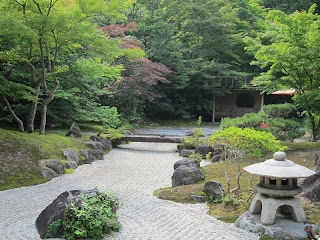Visiting Two Great Zen Temples In Matsushima Japan, The Zuiganji and Entsuin Zen Temples
The train from Sendai to Matsushima took about thirty minutes, and we disembarked on a train platform overlooking Matsushima bay.
Matsushima is the closest we got on this trip to the epicenter of the 2011 earthquake and the subsequent Tsunami.
Remnants of the widespread destruction are still very visible in some places.
We came to Matsushima to visit the famous Zen Temple of Zuiganji.
It is the last Zen temple on our Spiritual pilgrimage in Japan.
We knew that the main hall of the temple is undergoing major renovations that will last until the year 2018, but we were told that much of the temple grounds and other buildings were open to the public.
Matsushima is a scenic coastal area with a wide bay filled with many small rocky islands.
The area is famous for its scenic views, and as a result it was full of tourists, flooding the small town either from the sea in large tourist boats, or by cars and trains from Sendai.
After being in remote rural places for most of our trip, it felt almost annoying to walk in a long line following the many tourists.
The horns of the cruise ships, and the loudspeakers of tour guides, made walking on the main street by the water an unpleasant experience.
The heat of the day made it even less enjoyable, and we stopped to enjoy a pear ice cream cone, which melted in my hand.... It was a very HOT day.
We ducked into a side street just to avoid the tourists, and made our way to the Zuiganji Zen temple walking on the side streets that surprisingly were completely empty of tourists.
From the minute we entered the grounds of Zuiganji, I felt revived again.
Very tall cedar trees were densely planted on the grounds, and the green carpet below them was not green grass but beautiful bright moss.
One side of the entrance to the temple, had a long and elaborate cave system with rooms and many stone carvings.
In olden days, they were used as cool meditation spaces for the practicing monks, but since the year 1190, they were used as burial shrines and graves.
Zuiganji is one of the Tohoku Region's most famous and prominent Zen temples, and the area is so filled with old caves, that some of them are neglected and are even used as backgrounds to small parking lots.
It reminded me that after a long history of destruction and neglect, the Chinese government now takes such good care of their caves and grottos, opening only a few of them to the public and charging such huge entrance fees to see them....
Obviously the Japanese government has not yet grasped the beauty of its own culture and history...
At the gate, we handed over our spiritual pilgrim passport to be stamped, and made our way to explore the temple grounds.
Zuiganji was originally founded in the year 828 as a temple of the Tendai sect, and was converted into a Zen temple during the Kamakura Period (1192-1333).
After years of decline, Zuiganji was restored by a feudal lord named Datē Masamune, who rebuilt it as his family temple in 1609.
We visited the Zuiganji Art Museum which had some exhibits of the temple's treasures, including its golden Fusuma sliding doors, and artifacts of the Masamune Clan, including some beautiful Buddhist ritual props and a life sized wooden statue of Datē Masamune clothed in his armor.
We took a lovely stone path between large cedar trees, to see the renovated structure of Otamaya, the beautiful mausoleum of Masamune's wife.
This beautiful mausoleum is not normally open to the public, but because of the renovation of the main hall, we were allowed to visit it and admire the beautiful gold, reds and black colors of its intricate design.
It was amazing to see it stand exposed to the elements without cover...
I wondered how long the bright colors would last outdoors in the sun, rain and snow....
The zen temple next door is much smaller in size, but it is not less glorious.
It is called Entsuin Zen Temple, and at the entrance, Jules pointed to a sign saying that we could ask for a free English speaking guide.
I was not sure I wanted a guide... They usually tend to rush you through places, and leave no time to take photos, or to sit and meditate and take in the soul and spirit of the place..
So I said nothing, and we entered the beautiful garden of this Zen temple.
A friendly lady came almost running towards us, saying that she will be our guide, and that her name was Yuko Fujima.
Her eyes were so eager and sincere and her disposition so sweet, that we wholeheartedly obliged.
She was such a blessing and a wellspring of interesting information that we could NOT have found in the book or on the Internet.
Yuko Fujima-San, said that everything in this Zen garden, was symbolic of something... And that we needed to notice it... To think about it, to reflect on it, and to learn from it and that if we were mindful, everything offers an opportunity to grow from it...
She pointed to the paving stones I was standing on, and said that they represented the three stages of the human experience on this earth....childhood, adulthood, and old age.
At first glance, they all looked like paving stones, carved from the same black local Matsushima rock, but Yuko San called my attention to the fact that some were small and very rough, representing the rough stage of reckless youth....along with a body that is small in size.
The next set of stones were large, and a little worn out, but still had a rough surface to them.
Those, said Yuko San, represented adulthood, when the person still seeks for earthly things and material pursuits.... still is rough and quick to argue...but his body is larger in size.
And then she pointed to the nearby paving stones, which were not wide and big, but elongated and very smooth.
She said that those stones represented old age, in which a person has been smoothed and shaped by the trails of life.... Into a harmonious being...
This Zen Entsuin Temple was built in 1646, said Yuko San, and it has two kinds of gardens.
A Stone garden which represents a heavenly garden, and a garden with soil and trees, which represents an earthly garden.
Between the gardens there is a bridge.
The bridge has a stone on it, wrapped with a rope.
It indicates that you must not cross from the heavenly garden into the earthly garden.
(must not go backwards.)
A lovely path took us to the tomb of the son of the ruling local feudal lord Datē Terumune.
This whole Zen temple was built as a memory to his son and was devoted to Kannon, the Buddhist goddess of mercy.
The son of Datē Terumune was a bright and talented young boy, and it is believed that he was poisoned by a rival clan.
The mausoleum is a beautiful wooden building, set between great maple trees.
It houses a statue of the young lord, sitting on a white horse surrounded by his most devoted followers, who committed ritual suicide upon his death.
It was the ultimate act of devotion in those olden days, and soldiers and devotees killed themselves to follow their beloved leader into the afterlife, believing they could provide him with protection and that they would reincarnate together with him again.
The mausoleum's interior is decorated with gold leaf and ornate paintings, which include small symbols of spades, hearts, diamonds, clubs, crosses and the oldest Japanese image of a rose.
These symbols were included into the design because the Datē Clan had an interest in Christianity.
Yuko San was vague about whether or not the father had converted to Christianly, but she did say that since practicing Christianity was not allowed in Japan in the old days, the crosses and the Christian symbols were hidden into the design of the mausoleum, so they would not be discovered and destroyed.
Then we strolled and enjoyed the beauty of the earthly garden.
It was designed as two distinctly different gardens... One with a Japanese design, and one designed as a Western garden.
The Japanese garden has a beautiful design with moss and maples, native plants and flowers with tall bamboos and a heart shaped pond.
It also has a meditation section with purifying water and a lovely gazebo to shade the meditators.
The second earthly garden was a Western style rose garden, that had neatly trimmed edges, and a selection of many types of roses.
Yuko San said that normally a Zen temple would not have a rose garden in it.... but this was done as a sign of respect to the rose and the Christian symbols painted by the orders of the grieving father on his son's mausoleum.
I enjoyed spending time with Yuko San with all my heart and I delighted in chatting with her about this and that, and learning about the rounded pestle-like stones that were put on the graves of monks, while lay people got straight edge burial stones....
We thanked Yuko San and left the beautiful grounds of those adjoining Zen temples, and went back to the streets of Matshushima.
It was getting late in the day, and most of the crowd already left.
We could hear the distant horns of the cruise ships leaving the bay...
In a local restaurant I saw a lot of kids grilling something white on a stick.
It looked like mochi (rice cake) to me, so I joined them and ordered one.
A mother seated next to me was making sure that her children grilled the stick and not their fingers, and she told me it was Sasakamaboko, a famous fish cake that has been eaten in this area for over a thousand years.... The kids seemed to love it... And I also thought it was yummy.
I like trying new foods, even if they might not become a part of my regular diet (like Tomato ice cream).
The last thing that impressed me most in Matsushima, was the sight of a 700 year old Juniper tree.
This old juniper tree stood majestically twisting its branches into the sky in a most intricate design....
No matter how hard I tried, I could not capture its glory with my camera.
I must have taken dozens of photos.... But none could capture its glory...
The words Yuko San spoke about how she viewed old age, circulated in my mind, as I looked at this glorious old tree....
"We become smooth and more harmonious with time...."



















































































































